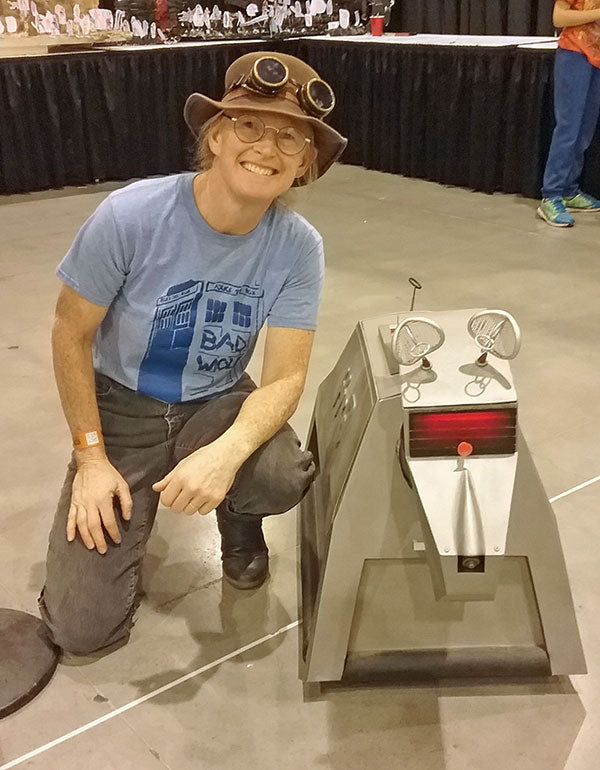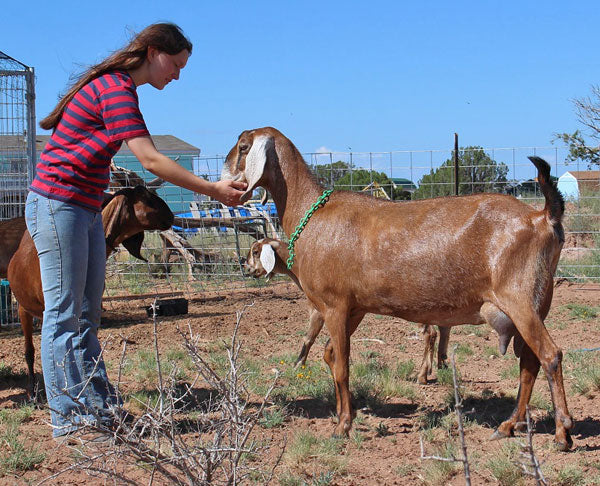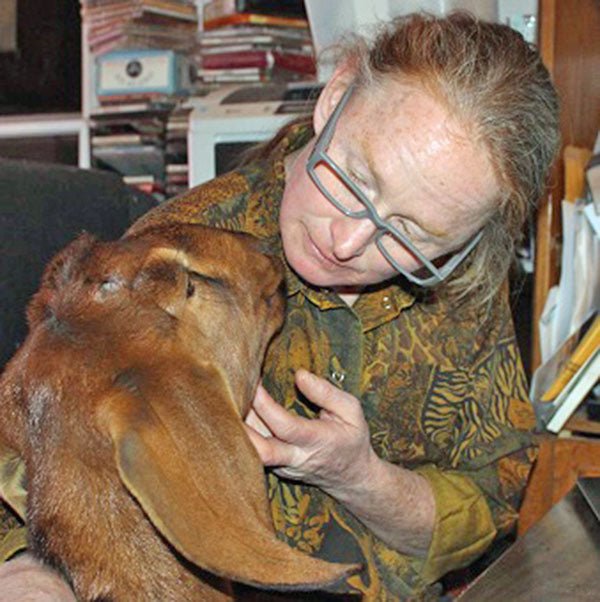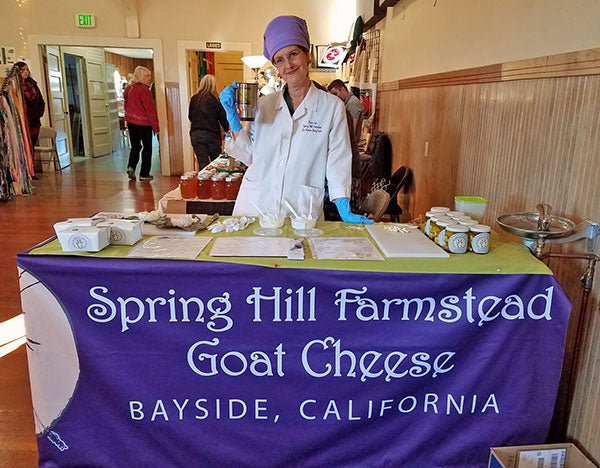
Wendy with Presto, her part-time house goat. He comes in to visit for a couple hours every night where he tries to scam pizza and snacks off the counter.
Wendy teaches high school chemistry and biology when she isn’t running her ranch – Witch Hazel Dairy. She is the proud mother of Hazel McGuffin, who is now in her first year of college. Wendy and her husband, Jorge took Hazel to the Phoenix Comic Fest recently and Hazel snapped some cool pics of her parents:

Wendy and K9

Wendy and Jorge saving the day.
Hazel became enamored with goats when she was 11 and Wendy and Jorge, had to decide what to do about that. When Wendy explained their reasoning and their decision to us, we immediately posted it in an article – Raising a Kid Who Loves Goats.

Hazel with Harry, Wish’s son who was born 2 weeks early and who nearly froze to death. Hazel had him in a sink of warm water to bring his temperature back up. He had actually been stiff and cold when Wendy found him, but he made a noise…! He did survive and thrive. They called him ‘Harry Potter,’ the boy who lived.
Wendy’s Story
Milking and milking and milking
We bottle feed our babies and in our experience, when the babies are born, we usually never have enough milk. The mamas are just beginning to ramp up their production and the babies are always convinced that they are starved. We end up thawing out milk that I’ve stored in the fall, and using that to feed hungry babies. Then, usually, we have a couple months of ‘lean milk;’ there’s enough for coffee in the morning, but the rest of the milk is rationed for babies first.
Once the babies start getting sold, we start having milk – usually right around late April. Then we go from ‘scarce’ to ‘where do I put all this milk?’ I have tested a number of strategies over the years, in defense of having any space in the refrigerator for anything else other than milk.
Initially, my daughter Hazel decided that she did not like the taste of goat milk. I refused to buy cow milk when I had countless jars of goat milk in the refrigerator and, in fact, we had set up a second fridge for the overflow. I told her that they were HER goats and HER goats’ milk and she better learn to like it. She learned to like it.
Hazel showing Athena at an ADGA show in New Mexico
Initially, we ate lots of cereal, made cream soups of many varieties, fed milk to chickens and dogs, and I tried once using it as a ‘booster’ fertilizer for growing giant pumpkins. I gave milk away. We tried goat milk ice cream with frozen blueberries – the best! Soured milk went into the compost pile. There was still too much milk.
Making cheese
 Before long, my friend Santra, who had had goats, came over with a wonderful book, Mary Jane Toth’s Goats Produce Too. I embarked on making cheese, using many of Mary Toth’s recipes.
Before long, my friend Santra, who had had goats, came over with a wonderful book, Mary Jane Toth’s Goats Produce Too. I embarked on making cheese, using many of Mary Toth’s recipes.
Cheese and yogurt are both wonderful ways to condense fluid milk into something that lasts longer, tastes different from milk and can further the ways that we ingest dairy products – AND TAKES UP LESS SPACE. About this time, I purchased a pasteurizer, so I could give cheese away and not worry about the goat milk having any pathogens in it. We ate cheese, we gave cheese away, the dogs ate cheese, the chickens ate cheese that had gone bad…
Still too much milk.
Now and then, someone would come by and explain that they had gotten baby goats and needed milk… So we were glad to help out. With one lady, we set up a situation where she could pick up milk in the refrigerator of a travel trailer on our property, and she would leave money to help with the goats’ feed. We’d leave her chard. She’d leave us fruit. We still see her once or twice a year to disbud her new babies.
This would go on during the summer and fall, then we’d have this horrible period of no milk. And no eggs, because, not coincidentally, the chickens are not laying during the winter. No fresh greens from the garden… Lots of potatoes and winter squash and noodles and sauces. Seasonal eating is not all it’s cut out to be – except in the summer!

Wendy’s mother being inspected by Sarina in 2013 or 2014.
Making more cheese
I basically make cheese in self-defense of refrigerator space; when you are milking 3 or 4 or 5 goats who make between 1/2 and 1 gallon of milk a day, refrigerator space becomes a premium commodity and kitchen fantasies start involving more space for another refrigerator. I would be happy to wax poetic about that, but I don’t have all that many pictures of… food.
I am, by and large, a contentious objector, to posting pictures of food that I make to social media…unless it is Really Amazing. My husband does Really Amazing. I do various varieties of condensing liquid milk into more solid milk. I have moved away from hard cheeses due to storage issues (I do have a wine cooler and there IS a waxed cheese in there, but I am literally afraid to open it and find out what might have happened in there).
I also do amazing soap, but soap requires relatively little milk and absolutely no nifty bacteria cultures.

Sandlewood & Amber soap available for sale (click here)
7 years ago, I started making cheese with the fervor of a trained lab scientist, which, at one time, I was. I was all about sterility, pasteurization, calibrating my thermometers against each other and having several out to check the exact temperatures, purchasing the minute measuring spoon for exactly the right amount of culture, and I seriously considered purchasing the pH strips… I made chevre, fromage blanc (from NECS – seriously one of our favorites), cultured mozzarella, cheddar cheese, cottage cheese and a few of the other hard cheeses. All the time, I always wondered how people made cheese before the advent of pasteurizers and pH strips and lovely frozen cultures. Cheese is NOT a new invention and humans have been making both seasonal and geographical varieties for generations.
 Then, I picked up a copy of The Cheeses and Wines of England and France by John Ehle, at a benefit auction at an ADGA dairy goat show. This understated narrative of the author’s travels to the old country of England and France, to learn how the geriatric cheese makers of old made their regional cheese is absolutely wonderful. I read the book cover to cover. More than anything else, I felt that what I learned from this book was that there is no one way to make cheese. John Ehle’s book gave me permission to relax and not be scurrying to my recipe every time, and not to agonize when something didn’t turn out how it was ‘supposed to be.’
Then, I picked up a copy of The Cheeses and Wines of England and France by John Ehle, at a benefit auction at an ADGA dairy goat show. This understated narrative of the author’s travels to the old country of England and France, to learn how the geriatric cheese makers of old made their regional cheese is absolutely wonderful. I read the book cover to cover. More than anything else, I felt that what I learned from this book was that there is no one way to make cheese. John Ehle’s book gave me permission to relax and not be scurrying to my recipe every time, and not to agonize when something didn’t turn out how it was ‘supposed to be.’
Now, in the continuation of my endeavor to keep at least some room in the refrigerator, I just…make cheese. What kind of cheese? I’ll tell you when I’m done, because the milk doesn’t always behave the way I want it to. With goats (and perhaps cows), early lactation milk has a different chemistry than late lactation milk.
That said, I have been told that you cannot make mozzarella with late lactation goat milk; late lactation milk is about the only milk I’ve been ever able to make mozzarella with. I basically make ‘soft’ type cheeses – I like the MM100 series of cultures for that. I make Feta type cheeses, but sometimes they turn into cottage cheese. I really enjoy cottage cheese, and we make that often. I try for large curd, and my husband makes a mean Paleek Paneer, which is my favorite dish from Indian cuisine. Traditional paneer, which I have made, doesn’t hold together as well as the cottage cheese, in our hands. And I make a spectacular yogurt. I finally invested in an Instant Pot for yogurts, and I strain a gallon of yogurt in two Greek yogurt strainers.
If, by chance, my experiments don’t work out, then the chickens get a bonus.
In fact, last fall, I hit on a way to cut down on chicken feed costs and get rid of excess goat milk – I made huge batches of ‘chicken cheese,’ which was a cottage-cheese type curd with lots of rennet. Our chickens prefer curds to soft cheese. Our chickens probably eat better than many humans in many third world countries.
Keeping Sylvia productive …
In the past eight years, the only time we managed to have ‘just enough’ milk in the refrigerator was this past winter, when we – for the first time – milked one of our girls, Sylvia, through the winter instead of drying her off.

Sylvia
Usually, we decide which goats we are going to breed in the fall, and then we dry everyone off in December, so we can go visiting family.
If you think finding someone to feed your dog while you are gone is difficult, I challenge you to find someone who is willing to come over, collect all the milking equipment, go out and clean udders and milk four or five 200 pound goats, each of whom has their own little peculiarities about which stand they want to get on, which grain they get, who is a ‘side milker’ and who is a ‘back milker,’ and how you get them out the milking parlor door without the other goats, the Cookie Pirates, snatching the milking girl’s cookies or trying to barge in for grain. Then, you have to process the milk immediately and clean all the stainless steel.
Exactly.
Thus, we can’t go anywhere together anymore, and someone ends up staying home. Thus, when the girls begin to naturally produce less milk in the fall, and they’ve been bred, we go ahead and move them to once-a-day milking and then, a few weeks later, they are usually producing much less and it’s safe to dry them off.
Sylvia, however, did not go into heat in the time-frame that would have had her produce her kids during either my or Hazel’s spring break, so she did not get bred this year. And, we just never got around to drying her off. It was lovely having fresh milk during the winter and my wonderful husband stepped up to become The Milker in Hazel’s absence. We decided to keep Sylvia in business until the babies were born, in case we lost a doe or the girls didn’t produce enough for the babies.

Hazel and Sylvia
Making soap
Then we learned about soap-making. The problem with soap-making with goat milk soap is that the soap really doesn’t require a lot of goat milk. It does require a lot of oils and lye, and the recipe that we use is really a luxury product. However, I now have two halves of a room and a dresser dedicated to storing oils and soap-molds, mica pigment, fragrances and finished soap. So in terms of trying to conserve storage space, this is the proverbial ‘one step forward, two steps backwards.’
Living the life
Now, we find ourselves in late April, milking four goats in the morning, and four, plus Sylvia, in the evening.

Hazel and Athena. Athena is retired and she lives in the doe pen with seven other girls, including her daughter. She will die and be buried on the property. They have several retired goats now: Athena, Robin, Sarah and Nebula.
Sylvia never got the memo that she was supposed to slow down her milk production – she does a half gallon a day and the girls are not only supplying 9 babies, but ourselves and our friends with whom we trade homemade baked goods for milk and dairy products. Sylvia doesn’t look like she’s even THINKING of slowing down, and the other girls are going gangbusters, even with our feeding between 3-4 gallons of milk to babies.
There’s a lot more opportunities to experiment in my future.
And Wish is going to be the ‘overwinter’ milker this year…

Hazel and Wish
Robin, the grey goat featured in several pictures and one of Hazel’s near-and-dear favorites, is really having a rough time and it’s my goal to keep her alive until Hazel gets home again to say goodbye. Robin has some sort of nervous system affliction that no one can figure out and she seemed to find eating frustrating, so she was dropping weight like crazy. I actually arranged to have her put down last weekend, but called it off.

Hazel with Robin and Batur, their livestock guardian dog
She is now in her own pen – which she is really liking – and she has a buffet of buckets laid out in front of her, is getting fresh fruit (grapes , or apples or cut up oranges) twice a day and chard and a daily injection of a non-steroidal anti-inflammatory and she’s actually doing better than I’ve seen her doing in months. She naps in the sun, is laying down again (she was doing nothing but standing nearly 24/7, and that’s very not-goat), and she’s mobile (though jerky), and she even tried to run after me yesterday – What’s in the bucket, G’ma?
That’s the sad part of keeping livestock that you give your heart to, though. Saying goodbye and knowing when to say goodbye.
Update on Robin 5/20/18: (It’s been a few weeks since Wendy first wrote about Robin.) Robin is now given the run of the whole yard, so she hobbles around and eats weeds and chard and naps anywhere she wants and if she hears us out and about, she will often make her way over to where we are, and hang out with us. However I don’t think she has much longer here. When she is no longer enjoying life, we’ll say goodbye.
Update on Robin 6/8/18: We put down Robin yesterday. It was tough, but our mentor Kathryn agreed that it was time. The vet we had out suspected she had a tumor growing in her brain and you could see Robin going down day by day.













































































































































